Impact of Interrepetition Rest on Muscle Blood Flow and Exercise Tolerance during Resistance Exercise
Abstract
:1. Introduction
2. Methods
2.1. General Overview of Experimental Approach
2.2. Subjects
2.3. Procedures
2.4. Familiarization Visit
2.5. Protocol #1: Determining the Effect of Interrepetition Rest on Muscle Blood Flow and Maximum Sustainable Power
2.6. Protocol #2: Determining the Impact of Interrepetition Rest on Exercise Tolerance and Blood Flow during Resistance Exercise with Heavy Weight
3. Results
3.1. Protocol #1: The Effect of Interrepetition Rest during High-Repetition, Low-Weight Resistance Exercise
3.2. Protocol #2: Impact of Interrepetition Rest on the Blood Flow and Tolerance to Heavy-Weight Resistance Exercise
4. Discussion
4.1. How Does Interrepetition Rest Impact Hemodynamics during Resistance Exercise?
4.2. Does Interrepetition Rest Increase the Power That Can Be Sustained during Resistance Exercise?
4.3. Does Interrepetition Rest Impact Tolerance to Heavy-Weight Resistance Exercise?
4.4. Does Interrepetition Rest Impact Muscle Blood Flow during Heavy-Weight Resistance Exercise?
4.5. Future Directions
4.6. Experimental Considerations
5. Conclusions
Author Contributions
Funding
Institutional Review Board Statement
Data Availability Statement
Acknowledgments
Conflicts of Interest
References
- Lawton, T.; Cronin, J.; Lindsell, R. Effect of Interrepetition Rest Intervals on Weight Training Repetition Power Output. J. Strength Cond. Res. 2006, 20, 172–176. [Google Scholar]
- García-Ramos, A.; Padial, P.; Haff, G.G.; Argüelles-Cienfuegos, J.; García-Ramos, M.; Conde-Pipó, J.; Feriche, B. Effect of different interrepetition rest periods on barbell velocity loss during the ballistic bench press exercise. J. Strength Cond. Res. 2015, 29, 2388–2396. [Google Scholar] [CrossRef]
- Tufano, J.J.; Brown, L.E.; Haff, G.G. Theoretical and Practical Aspects of Different Cluster Set Structures. J. Strength Cond. Res. 2016, 31, 848–867. [Google Scholar] [CrossRef]
- Tufano, J.J.; Conlon, J.A.; Nimphius, S.; Brown, L.E.; Petkovic, A.; Frick, J.; Gregory Haff, G. Effects of Cluster Sets and Rest-Redistribution on Mechanical Responses to Back Squats in Trained Men. J. Hum. Kinet. 2017, 58, 35–43. [Google Scholar] [CrossRef] [Green Version]
- Iglesias-Soler, E.; Boullosa, D.A.; Carballeira, E.; Sánchez-Otero, T.; Mayo, X.; Castro-Gacio, X.; Dopico, X. Effect of set configuration on hemodynamics and cardiac autonomic modulation after high-intensity squat exercise. Clin. Physiol. Funct. Imaging 2015, 35, 250–257. [Google Scholar] [CrossRef]
- Paulo, A.C.; Tricoli, V.; Queiroz, A.; Laurentino, G.; Forjaz, C. Blood pressure response during resistance training of different work-to-rest ratio. J. Strength Cond. Res. 2019, 33, 399–407. [Google Scholar] [CrossRef]
- Harris, R.C.; Edwards, R.H.T.; Hultman, E.; Nordesjö, L.O.; Nylind, B.; Sahlin, K. The time course of phophorylcreatine resynthesis during recovery of the quadriceps muscle in man. Pflugers Arch. 1976, 367, 137–142. [Google Scholar] [CrossRef]
- Broxterman, R.M.; Craig, J.C.; Smith, J.R.; Wilcox, S.L.; Jia, C.; Warren, S.; Barstow, T.J. Influence of blood flow occlusion on the development of peripheral and central fatigue during small muscle mass handgrip exercise. J. Physiol. 2015, 59317, 4043–405417. [Google Scholar] [CrossRef] [Green Version]
- Petrick, H.L.; Pignanelli, C.; Barbeau, P.; Churchward-venne, T.A.; Dennis, K.M.J.H.; Van Loon, L.J.C.; Burr, J.F.; Goossens, G.H.; Holloway, G.P.; Hogan, M.; et al. Blood flow restricted resistance exercise and reductions in oxygen tension attenuate mitochondrial H2O2 emission rates in human skeletal muscle. J. Physiol. 2019, 15, 3985–3997. [Google Scholar] [CrossRef]
- Bonde-Petersen, F.; Mørk, A.L.; Nielsen, E. Local muscle blood flow and sustained contractions of human arm and back muscles. Eur. J. Appl. Physiol. Occup. Physiol. 1975, 34, 43–50. [Google Scholar] [CrossRef]
- MacDougall, J.D.; Tuxen, D.; Sale, D.G.; Moroz, J.R.; Sutton, J.R. Arterial blood pressure response to heavy resistance exercise. J. Appl. Physiol. 1985, 58, 785–790. [Google Scholar] [CrossRef] [PubMed] [Green Version]
- Sadamoto, T.; Bonde-Petersen, F.; Suzuki, Y. Skeletal muscle tension, flow, pressure, and EMG during sustained isometric contractions in humans. Eur. J. Appl. Physiol. Occup. Physiol. 1983, 51, 395–408. [Google Scholar] [CrossRef] [PubMed]
- Thomas, K.N.; Kissling, L.S.; Gibbons, T.D.; Akerman, A.P.; van Rij, A.M.; Cotter, J.D. The acute effect of resistance exercise on limb blood flow. Exp. Physiol. 2020, 105, 2099–2109. [Google Scholar] [CrossRef] [PubMed]
- MacDougall, J.D.; McKelvie, R.S.; Moroz, D.E.; Sale, D.G.; McCartney, N.; Buick, F. Factors affecting blood pressure during heavy weight lifting and static contractions. J. Appl. Physiol. 1992, 73, 1590–1597. [Google Scholar] [CrossRef] [PubMed]
- Scott, B.R.; Peiffer, J.J.; Thomas, H.J.; Marston, K.J.; Hill, K.D. Hemodynamic responses to low-load blood flow restriction and unrestricted high-load resistance exercise in older women. Front. Physiol. 2018, 9, 1324. [Google Scholar] [CrossRef]
- Burnley, M.; Vanhatalo, A.; Jones, A.M. Distinct profiles of neuromuscular fatigue during muscle contractions below and above the critical torque in humans. J. Appl. Physiol. 2012, 113, 215–223. [Google Scholar] [CrossRef]
- Hammer, S.M.; Alexander, A.M.; Didier, K.D.; Huckaby, L.M.; Barstow, T.J. Limb blood fl ow and muscle oxygenation responses during handgrip exercise above vs. below critical force. Microvasc. Res. 2020, 131, 104002. [Google Scholar] [CrossRef]
- Joyner, M.J.; Casey, D.P. Regulation of Increased Blood Flow (Hyperemia) to Muscles During Exercise: A Hierarchy of Competing Physiological Needs. Physiol. Rev. 2015, 95, 549–601. [Google Scholar] [CrossRef] [Green Version]
- Hughes, W.E.; Ueda, K.; Treichler, D.P.; Casey, D.P. Rapid onset vasodilation with single muscle contractions in the leg: Influence of age. Physiol. Rep. 2015, 3, 2499–2504. [Google Scholar] [CrossRef] [Green Version]
- Paulo, A.C.; Forjaz, C.L.M.; Mion, D.; Silva, G.V.; Barros, S.; Tricoli, V. Blood Pressure Increase in Hypertensive Individuals During Resistance Training Protocols With Equated Work to Rest Ratio. Front. Physiol. 2020, 11, 481. [Google Scholar] [CrossRef]
- Gifford, J.R.; Richardson, R.S. CORP: Ultrasound Assessment of Vascular Function with the Passive Leg Movement Technique. J. Appl. Physiol. 2017, 123, 1708–1720. [Google Scholar] [CrossRef] [PubMed]
- Stanhewicz, A.A.E.; Wong, B. Counterpoint: Investigators should not control for menstrual cycle phase when performing studies of vascular control that include women. J. Appl. Physiol. 2020, 129, 1117–1119. [Google Scholar] [CrossRef]
- Gifford, J.R.; Bloomfield, T.; Davis, T.; Addington, A.; McMullin, E.; Wallace, T.; Proffit, M.; Hanson, B. The effect of the speed and range of motion of movement on the hyperemic response to passive leg movement. Physiol. Rep. 2019, 7, e14064. [Google Scholar] [CrossRef] [PubMed] [Green Version]
- Gifford, J.R.; Hanson, B.E.; Proffit, M.; Wallace, T.; Kofoed, J.; Griffin, G.; Hanson, M.; Jayson Gifford, C.R. Indices of leg resistance artery function are independently related to cycling VO2max. Physiol. Rep. 2020, 8, e14551. [Google Scholar] [CrossRef]
- Hanson, B.E.; Proffit, M.; Gifford, J.R. Vascular function is related to blood flow during high-intensity, but not lowintensity, knee extension exercise. J. Appl. Physiol. 2020, 128, 698–708. [Google Scholar] [CrossRef]
- Broxterman, R.M.; Ade, C.J.; Wilcox, S.L.; Schlup, S.J.; Craig, J.C.; Barstow, T.J. Influence of duty cycle on the power-duration relationship: Observations and potential mechanisms. Respir. Physiol. Neurobiol. 2014, 192, 102–111. [Google Scholar] [CrossRef] [PubMed]
- Powers, S.; Howley, E. Common Measurements in Exercise Physiology. In Exercise Physiology:Theory and Application to Fitness and Performance; McGraw Hill: New York City, NY, USA, 2018; pp. 16–29. ISBN 978-1-259-87045-3. [Google Scholar]
- Hammer, S.M.; Alexander, A.M.; Didier, K.D.; Barstow, T.J. Influence of blood flow occlusion on muscular recruitment and fatigue during maximal-effort small muscle-mass exercise. J. Physiol. 2020, 598, 4293–4306. [Google Scholar] [CrossRef]
- Ratamess, N.; Alvar, B.; Evetoch, T.; Kibler, W.; Kraemer, W.; Triplett, N. Progression Models in Resistance Training for Healthy Adults. Med. Sci. Sports Exerc. 2014, 9, 687–708. [Google Scholar] [CrossRef]
- Salvador, A.F.; Askow, A.T.; McKenna, C.F.; Fang, H.Y.; Burke, S.K.; Li, Z.; Ulanov, A.V.; Paluska, S.A.; Petruzzello, S.J.; Boppart, M.D.; et al. Resistance Exercise-induced Regulation of Muscle Protein Synthesis to Intraset Rest. Med. Sci. Sports Exerc. 2020, 52, 1022–1030. [Google Scholar] [CrossRef]
- Byrd, R.; Centry, R.; Boatwright, D. Effect of inter-repetition rest intervals in circuit weight training on PWC170 during arm-cranking exercise. J. Sports Med. Phys. Fitness 1988, 28, 336–340. [Google Scholar] [PubMed]
- Heinonen, I.; Koga, S.; Kalliokoski, K.K.; Musch, T.I.; Poole, D.C. Heterogeneity of Muscle Blood Flow and Metabolism: Influence of Exercise, Aging, and Disease States. Exerc. Sport Sci. Rev. 2015, 43, 117–124. [Google Scholar] [CrossRef] [PubMed] [Green Version]
- Lixandrão, M.E.; Ugrinowitsch, C.; Berton, R.; Vechin, F.C.; Conceição, M.S.; Damas, F.; Libardi, C.A.; Roschel, H. Magnitude of Muscle Strength and Mass Adaptations Between High-Load Resistance Training Versus Low-Load Resistance Training Associated with Blood-Flow Restriction: A Systematic Review and Meta-Analysis. Sport. Med. 2018, 48, 361–378. [Google Scholar] [CrossRef] [PubMed]
- Crossley, K.W.K.W.; Porter, D.A.D.A.; Ellsworth, J.; Caldwell, T.; Feland, J.B.B.; Mitchell, U.; Johnson, A.W.W.; Egget, D.; Gifford, J.R.J.R. Effect of Cuff Pressure on Blood Flow during Blood Flow-restricted Rest and Exercise. Med. Sci. Sports Exerc. 2020, 52, 746–753. [Google Scholar] [CrossRef]
- Oliver, J.M.; Jagim, A.R.; Sanchez, A.C.; Mardock, M.A.; Kelly, K.A.; Meredith, H.J.; Smith, G.L.; Greenwood, M.; Parker, J.L.; Riechman, S.E.; et al. Greater gains in strength and power with intraset rest intervals in hypertrophic training. J. Strength Cond. Res. 2013, 27, 3116–3131. [Google Scholar] [CrossRef] [Green Version]
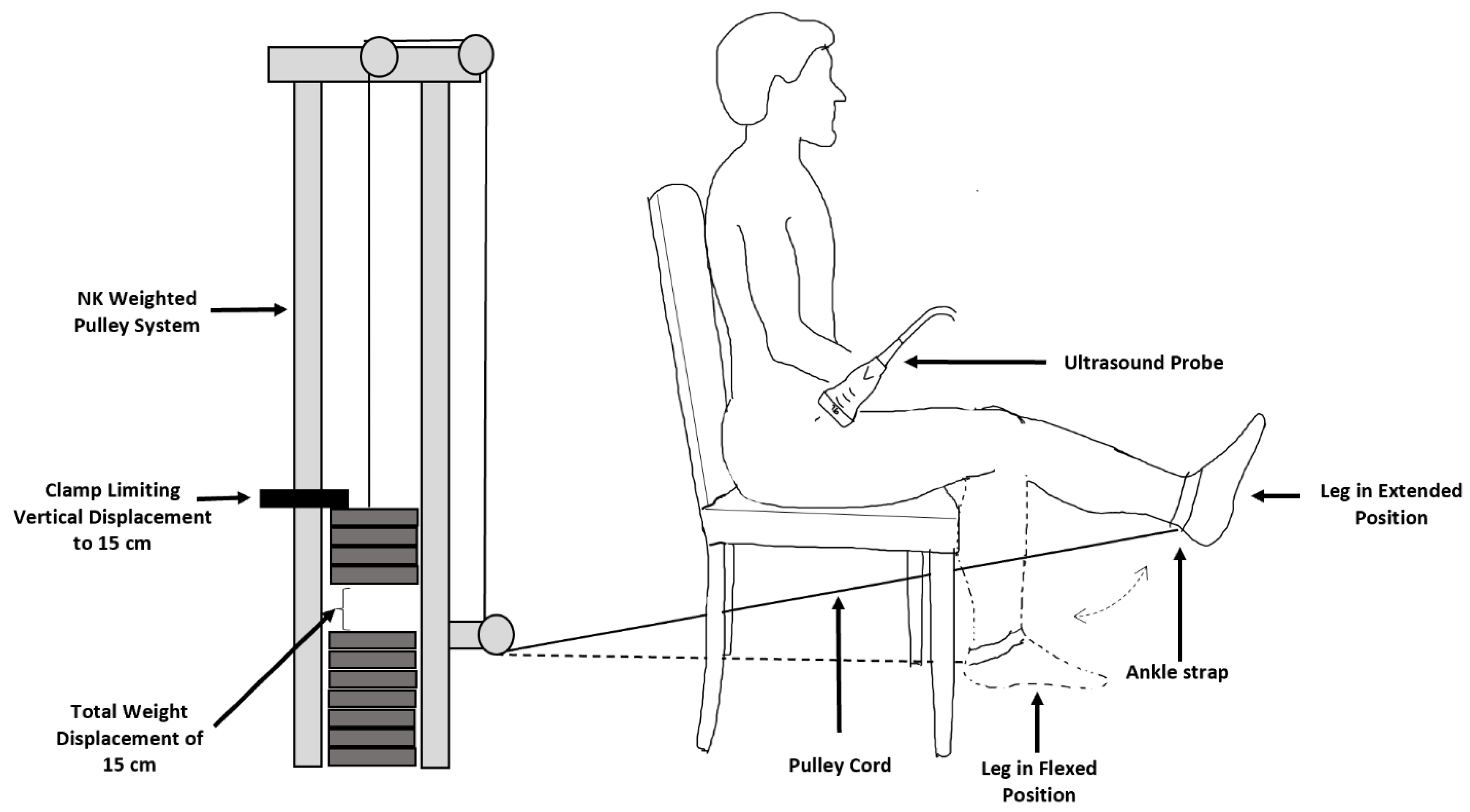
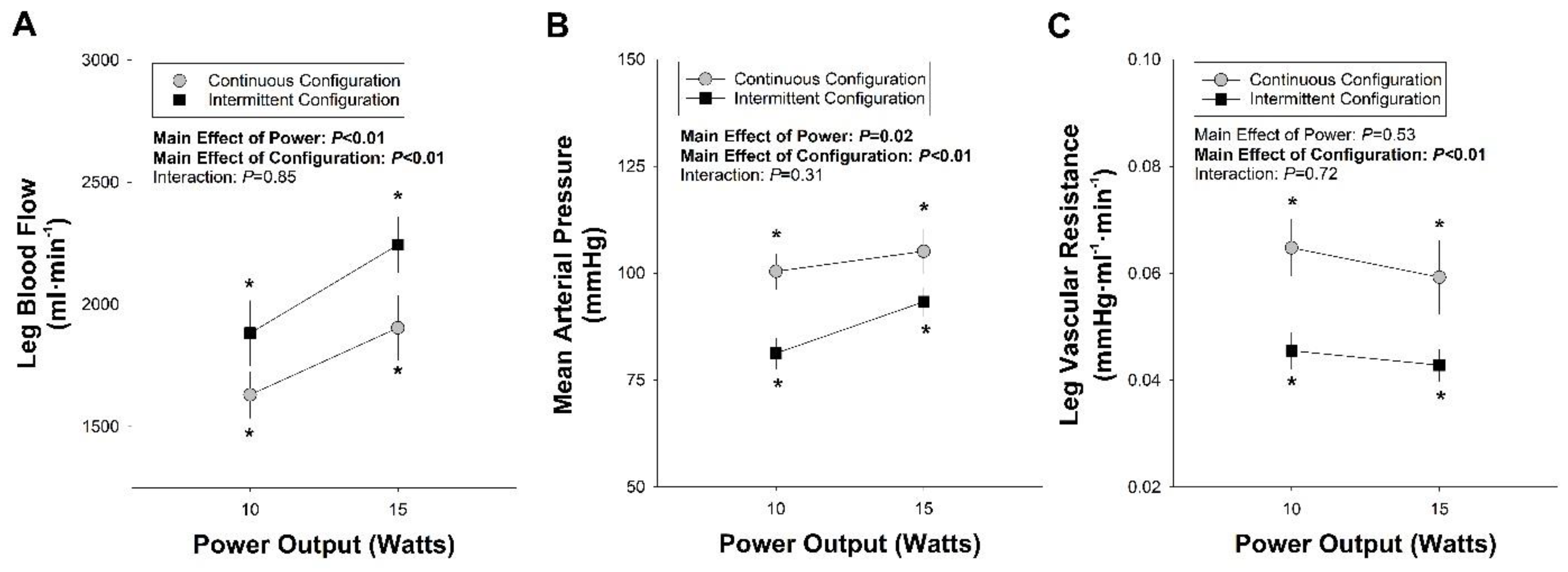
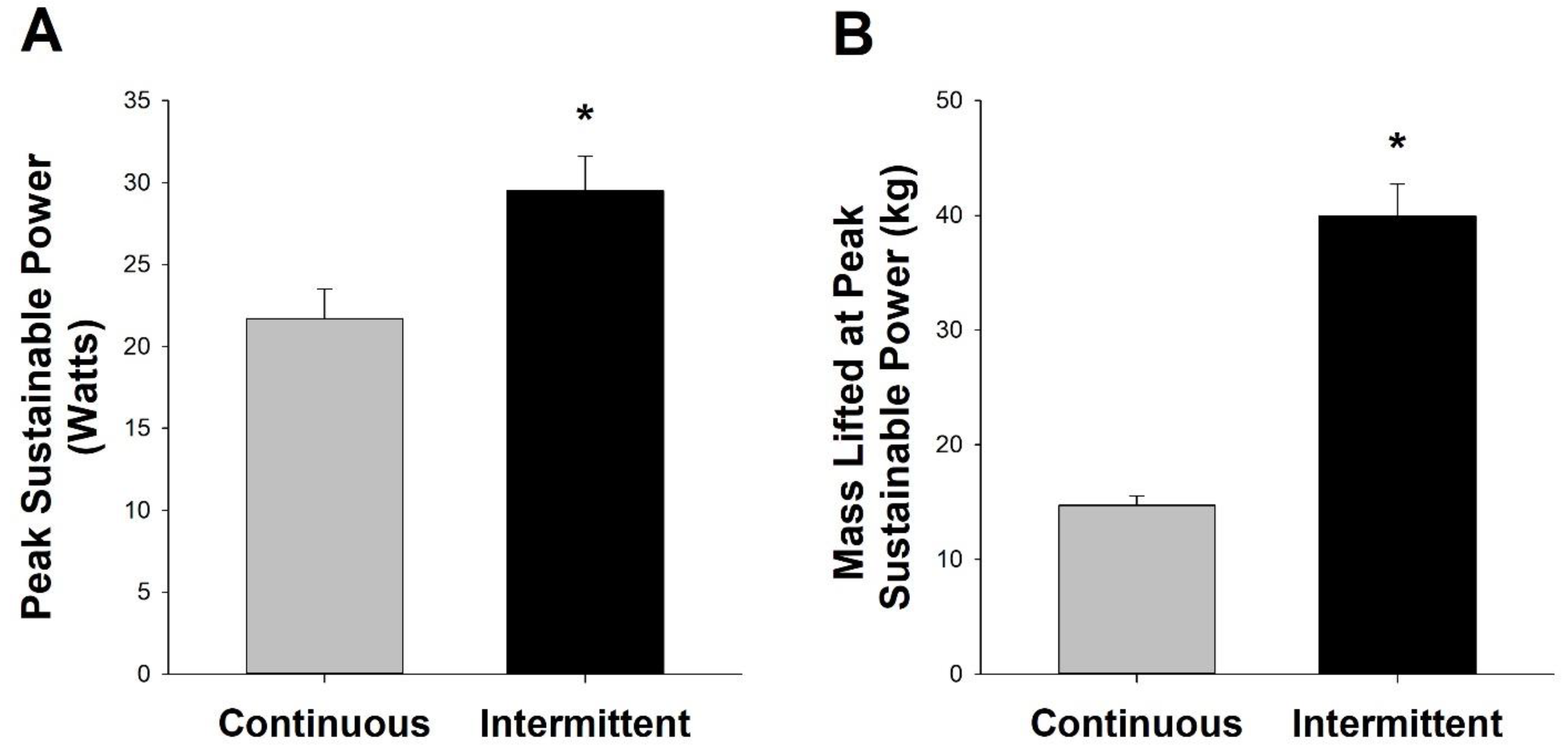
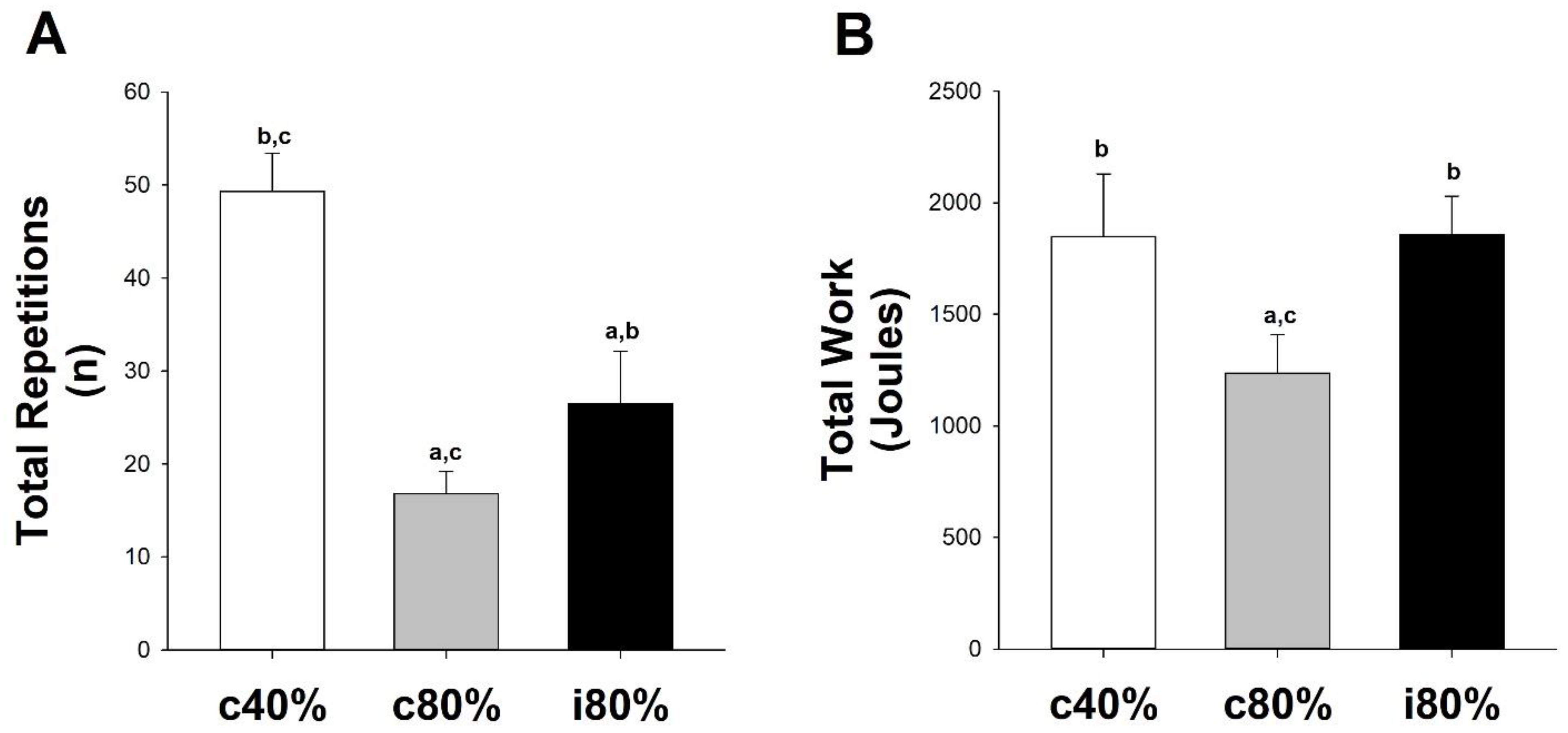
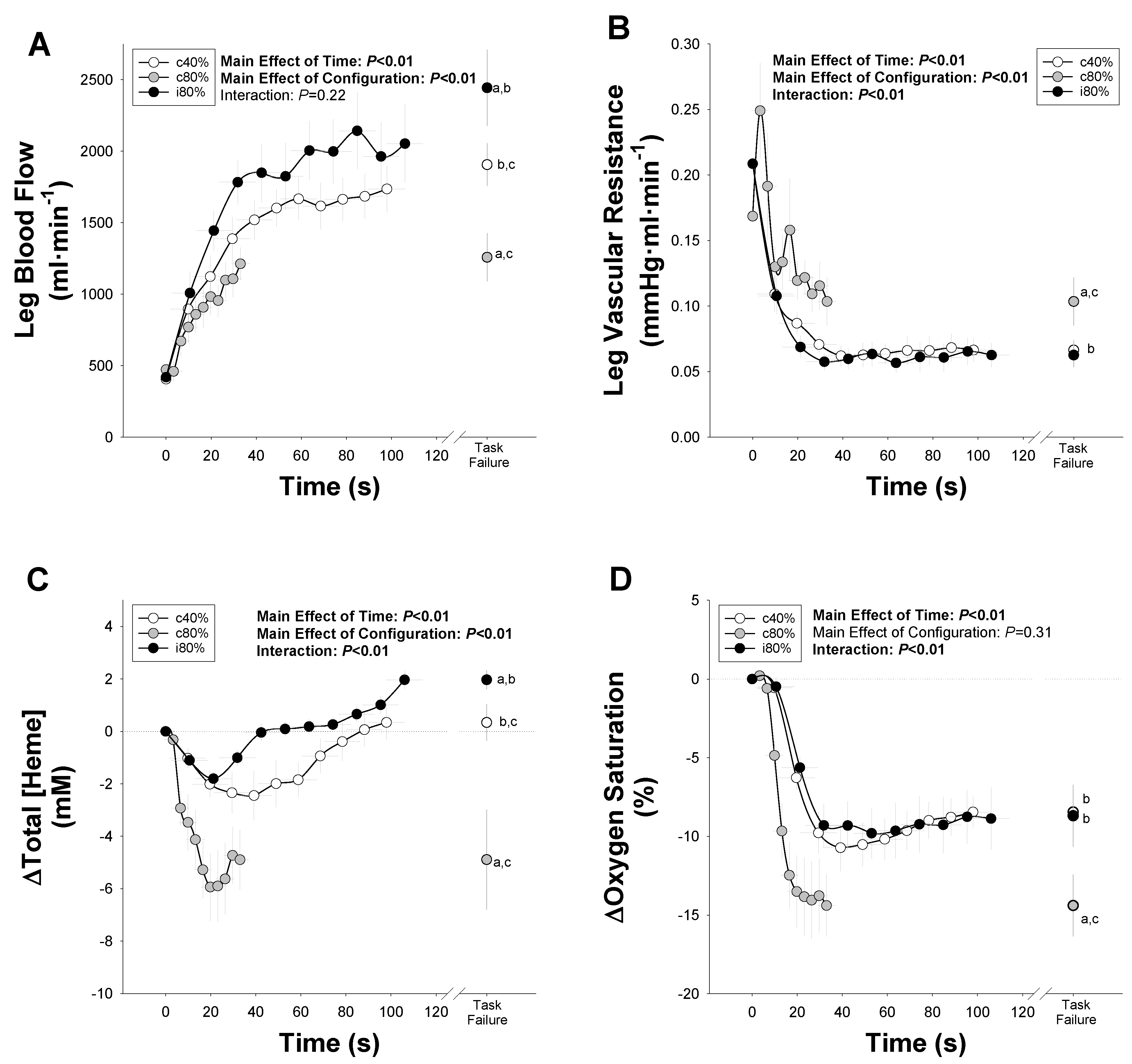
Publisher’s Note: MDPI stays neutral with regard to jurisdictional claims in published maps and institutional affiliations. |
© 2022 by the authors. Licensee MDPI, Basel, Switzerland. This article is an open access article distributed under the terms and conditions of the Creative Commons Attribution (CC BY) license (https://creativecommons.org/licenses/by/4.0/).
Share and Cite
Gifford, J.; Kofoed, J.; Leach, O.; Wallace, T.; Dorff, A.; Hanson, B.E.; Proffit, M.; Griffin, G.; Collins, J. Impact of Interrepetition Rest on Muscle Blood Flow and Exercise Tolerance during Resistance Exercise. Medicina 2022, 58, 822. https://doi.org/10.3390/medicina58060822
Gifford J, Kofoed J, Leach O, Wallace T, Dorff A, Hanson BE, Proffit M, Griffin G, Collins J. Impact of Interrepetition Rest on Muscle Blood Flow and Exercise Tolerance during Resistance Exercise. Medicina. 2022; 58(6):822. https://doi.org/10.3390/medicina58060822
Chicago/Turabian StyleGifford, Jayson, Jason Kofoed, Olivia Leach, Taysom Wallace, Abigail Dorff, Brady E. Hanson, Meagan Proffit, Garrett Griffin, and Jessica Collins. 2022. "Impact of Interrepetition Rest on Muscle Blood Flow and Exercise Tolerance during Resistance Exercise" Medicina 58, no. 6: 822. https://doi.org/10.3390/medicina58060822
APA StyleGifford, J., Kofoed, J., Leach, O., Wallace, T., Dorff, A., Hanson, B. E., Proffit, M., Griffin, G., & Collins, J. (2022). Impact of Interrepetition Rest on Muscle Blood Flow and Exercise Tolerance during Resistance Exercise. Medicina, 58(6), 822. https://doi.org/10.3390/medicina58060822





